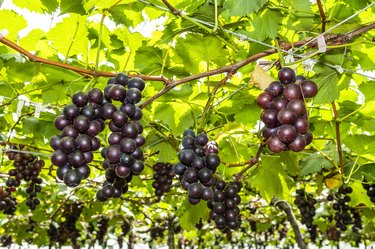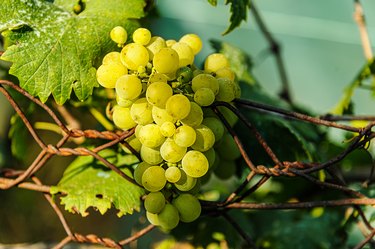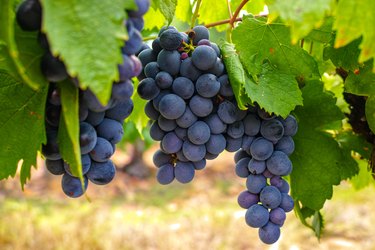
Grapes (Vitis spp.) are fruiting vines that thrive in U.S. Department of Agriculture plant hardiness zones 4 through 10, depending on the species and cultivar. Successful grape pollination ranges can occur either from self-fertile vines or from those requiring cross pollination with a compatible cultivar. In addition, some grapes may produce only male or female flowers and thus require a second plant with flowers of the opposite sex.
Tip
Grape pollination varies depending on the species and cultivar. Some are self-fruitful and others require pollination from a compatible variety.
Video of the Day
About the Grape Species
While there are approximately 80 grape species, the grapes found in most gardens are the European grapes (Vitis vinifera), hardy in USDA zones 7 through 10, the North American grapes (Vitis labrusca), hardy in USDA zones 4 through 7, and the muscadine grapes (Vitis rotundifolia), also a North American species found in USDA zones 7 through 10. In addition, there are a multitude of hybrids developed for flavor, cold or heat hardiness, usage and seedlessness.
Video of the Day

European grapes are primarily grown for winemaking or eating fresh. Well-known cultivars include wine grapes 'Chardonnay' and 'Zinfandel' and table grapes 'Flame Seedless' and 'Thompson Seedless.' North American grapes, such as 'Concord' and 'Niagara,' are often used for jelly and grape juice. Muscadine grapes, also called 'Scuppernong,' are eaten fresh as well as used in making wine, juice and jelly.
Grape Pollination: Self-Fruitful Types
Many grape cultivars are self-fruitful or self-pollinating. While they technically don't need a second plant to produce fruits, busy bees and other pollinators carrying pollen from one flower to the next results in a larger harvest. Plant several vines of either the same or compatible cultivars.
Grape Pollination: Cross-Pollination
Originally most wild grapevines produced either male or female flowers, with a few plants having self-fertile flowers. A grapevine that never produces fruit is probably a single sex plant. You can examine the flowers to see if they have well-developed ovaries, which indicates female or self-fertile blossoms. If the flowers appear to be female, try planting a self-fertile grapevine nearby to see if the vine begins producing fruits.
A few cultivars need a pollinator of a different but compatible cultivar. North American grapes 'Eona,' 'Minnesota 78' and 'Severnji,' hardy down to USDA zone 3, all produce female flowers and require a second self-pollinating cultivar, such as 'Beta' or 'Valiant,' planted nearby to produce fruits.
Muscadine grapes, depending on the cultivar, are among the grapes that may need a second, compatible cultivar for cross-pollination. By planting a self-fertile cultivar, such as 'Carlos,' 'Magnolia' or 'Paulk,' or a male cultivar like 'Bronze Dixie Sweet Scuppernong' or 'Black Southland Muscadine' within 50 feet of your female muscadines, you'll have fruit on your grapevines. The scuppernongs have pink, red or bronze fruits; they are also muscadine grapes and will cross pollinate with their purple to black fruiting neighbors.
Grape Growing Tips

Grapes produce their tasty fruits on new growth. To control the vigorous vines and encourage fruiting, put on your safety gear and sterilize your cutting tools in Lysol, then prune the dormant vines severely in late winter or early spring. Prune above the graft line and remove approximately 95 percent of last season's growth, leaving only the trunk and a few lateral canes along the trellis, fence or pergola.
Water deeply to encourage root growth, especially in spring and midsummer. Avoid wetting the foliage; use soaker hoses or a hose-end bubbler. Fertilize in spring with well-decomposed manure or compost or a slow-release 5-10-10 fertilizer. Always water after fertilizing.
After the fruit clusters begin to develop, remove every other cluster to give the grapes room to develop. Also, thin the foliage as needed to provide air circulation through the vines and around the grape clusters. This helps discourage fungal diseases, such as powdery mildew.